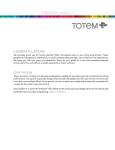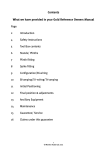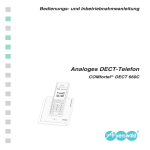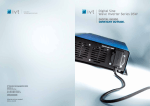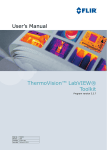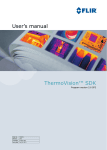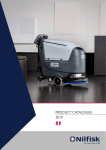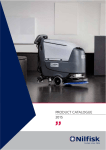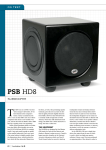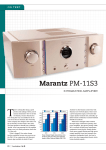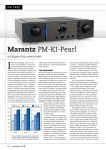Download Definitive Technology SC4000
Transcript
ON TEST Definitive Technology SC4000 Subwoofer M ine’s bigger than yours! That’s one thing you’ll never be able to say about Definitive Technology’s new SC4000 subwoofer, because it’s one of the smallest subwoofers I have ever reviewed. However you will be able to boast about something, because its digital display is by far and away the largest I have ever seen on a subwoofer… indeed it’s almost ridiculously big. What were they thinking? But you will also be able to boast about the level of performance you’re getting, because for a small sub the SC4000 packs a powerful punch… and for not a whole lot of money. 48 Australian The Equipment The reason the display is so large is that it’s always ‘hidden’ underneath the black cloth covering that Definitive Technology uses as a finish for most of its speakers, so if it were the usual size, you probably wouldn’t be able to see it—or you’d be able to see it, but not be able to distinguish the numerals. A highgloss piano lacquer top plate, adds a touch of class, and there is an ‘edge’ of black gloss panelling around the base of the subwoofer, but otherwise both sides and the front of the subwoofer are covered by black cloth. I am not normally a fan of clothed finishes, but on the SC4000 I think it works quite well. The driver complement of the SC4300 ‘SuperCube’ (about which I’ll have more to say later on in this review) comprises a single driven element (a 203mm-diameter bass driver) and two passive elements (two 203mm passive ‘plate-style’ auxiliary bass radiators, which are usually called ‘drones’ or ‘ABRs’). Definitive Technology calls these latter two units ‘pressure coupled planar low bass drivers’ which is a pretty good—and a pretty accurate—description. Basically, these two drivers are not connected to the amplifier at all. Instead, they’re forced to move by changes in air pressure within the cabinet caused by the single front-firing driver’s movement. Definitive Technology SC4000 Subwoofer As it moves outwards, rarefying the air inside the cabinet, the two passive drivers are pushed inwards by the air pressure in the listening room. As the front-firing driver moves inwards it compresses the air inside the cabinet, forcing the two passive drivers to move outwards. This to-and-fro motion of the passive radiators generates low-frequency sound waves. This ‘pressurised air’ drive system works best at low frequencies and even better when the cabinet containing the drivers is small, because it results in larger differences in air pressure than would be possible in a larger cabinet. However there is still a slight time delay involved between the action and the reaction, and the coupling effect also works better at mid-to high volume levels than it does at low levels. However, with regard to this last, Definitive Technology has provided a ‘fix’ in the form of a ‘Night Mode’ circuit, which compresses the dynamic range of the subwoofer so that, in the company’s words, ‘the loudest bass in a movie doesn’t get loud enough to wake the kids’, which is why it’s called a Night Mode circuit. However, you can also use this circuit to increase the apparent level of bass when playing at low volume, effectively increasing the output of the passive radiators. As for that single front-firing driver (which has a polypropylene cone and a Thiele/Small diameter of 165mm, for an Sd of 214cm²), it’s driven by a ‘BASH’ amplifier that Definitive Technology rates at 1,200-watts. BASH™ (the letters stand for Bridged Amplifier Switching Hybrid), is a trademark owned by US company Indigo, which holds US patents (#5,075,634 and #5,510,753) for this amplifier type, which is essentially an analogue Class-AB amplifier that uses a fast-response, pulse-width modulated power supply to deliver what is arguably a Class-H amplifier. In a ‘Class-H’ topology, rather than the rail voltage being fixed it is instead continuously varied in time with the incoming audio signal, a technique that allows very highefficiency operation, and is usually called a ‘rail-tracking’ or ‘tracking’ topology. (Though the general BASH topology also bears similarities with Class-G and Class-D amplifiers.) The output devices used in BASH modules are MOSFETs (Metal Oxide Semiconductor Field Effect Transistors) that are deployed in bridged Class-B mode. The power for these is provided by a switch-mode power supply whose output voltage is controlled by an audio processor that generates a PWM ‘gate pulse’ for the BASH converter. Although the BASH audio processor uses much the same schema as Class-D pulse width modulation (PWM) digital amplifiers, it controls the rail voltage rather than the audio signal itself, which is handled (in analogue) by the MOSFETs. For those who are interested in the history behind the BASH circuit, the applicable patent is US patent #5,075,634 (for a ‘Composite Bridge Amplifier’) where the inventor is named as one John B. French. You get more than the usual control over what the BASH amp does, in that in addition to adjusting volume, phase (you can choose between four fixed settings: 0°, 90°, 180°, and 270° ) and crossover frequency (18 fixed settings to choose from, starting at 40Hz then proceeding in 5dB steps to 100Hz, after which in 10dB steps to 150Hz) you can also invoke the ‘Night Mode’ mentioned previously, as well as toggle between four differently pre-programmed EQ settings that alter the frequency response of the SC4000. According to Definitive Technology’s ‘User Manual’, the EQ1 setting ‘maximises the lowest bass, but in so doing, sacrifices maximum volume level’, so that you won’t be able to play the SC4000 as loud using this setting as you will when you’re not using it. EQ2 raises the level of the midbass frequencies, which Definitive Technology says ‘is a good choice for hip-hop and rock music’. EQ3 raises the level of mid and ultra-low bass, which Definitive Technology says is: ‘a great setting for movies when not played at ultra-high volume levels’. EQ4 is (and again this is according to Definitive Technology), ‘the best setting to use when achieving maximum volume levels with minimal distortion is more important than reproducing the lowest frequencies.’ Of course you can also switch the EQ off entirely and, indeed, Definitive Technology says (and I concur): ‘this is the best starting point.’ The User Manual warns against using EQ1 at high volume levels, but if you do, the SC4000 has an overdrive circuit built in that will shut the whole subwoofer down if it’s either overdriven, or simply gets too hot. If it has overheated, the protection circuit automatically resets itself once the subwoofer has cooled down, whereas if the problem is overpowering, the protection circuit will reset only after you turn the volume down. Amplifier control can be managed via pushbutton controls on the rear of the subwoofer but, as I quickly discovered, this is a hopeless way to try to change the settings because the display that tells you what you’re doing is at the front of the subwoofer. So unless you have extraordinarily long arms and/or your eyes can focus up close rather better than mine are able to do (the display being so big!), you will find it quite difficult to use the rear panel controls while you’re looking at the display. The good news is that ON TEST Definitive Technology includes with every SC4000 a small (actually, it’s tiny, measuring just 47×100×7mm) infra-red remote control that will allow you to make all your adjustments from the comfort of your own listening chair… which is actually the best place to make such adjustments. The remote also offers ‘Mute’ and power ‘On/Off’ buttons, neither of which are available on the subwoofer itself. Power button notwithstanding, you don’t actually have to use it to turn the subwoofer on or off: the SC4000 will do that itself automatically via a signal-sensing circuit. If the sub is off and it detects that you have started playing music or a movie, it will turn on instantly. Definitive Technology SC4000 DSP Subwoofer Brand: Definitive Technology Model: SC4000 Category: Powered Subwoofer RRP: $1,545 Warranty: 3/5 Years Distributor: Advance Audio Australia Address: Unit 8, 509–529 Parramatta Rd Leichhardt, NSW 2040 (02) 9561 0799 [email protected] www.advanceaudio.com.au • Large display • Wireless option • Small footprint • Large display • Size of remote • Display typeface LAB REPORT Readers interested in a full technical appraisal of the performance of the Definitive Technology SC4000 Subwoofer should continue on and read the LABORATORY REPORT published on page 82. Readers should note that the results mentioned in the report, tabulated in performance charts and/or displayed using graphs and/ or photographs should be construed as applying only to the specific sample tested. Lab Report on page 82 avhub.com.au 49 ON TEST Definitive Technology SC4000 Subwoofer When you stop playing, the subwoofer will remain in a powered-up ‘ready’ state for around an hour before it decides you have definitely finished for the day, upon which it will turn itself off. (When I say ‘Off’, it’s not completely ‘Off’ of course; it’s just in standby mode, so you’ll be pleased to hear it draws less than 0.5-watts in this mode, which is low enough to earn the SC4000 an ‘Energy Star’ rating for being green.) As you can see from the photograph, there’s a gaping recess on the rear of the subwoofer control plate that’s marked ‘Wireless Adaptor Port’. So, if you find the best position for the SC4000 is at the back or side of your room (for either acoustic and/or aesthetic reasons) and you do not want to run a wire from it all the way back to your main system, you can pay $85 extra for the SCW-100 wireless link which buys you both the transmitter and receiver. Remember, however, that there is one wire you cannot eliminate with the wireless link… and that’s the 240V cable that you’ll need to run from the SC4000 to the nearest power point. One advantage of having the passive radiators on opposite sides of the cabinet is that some of the inevitable unwanted cabinet vibrations will be cancelled, but there is still some cabinet vibration caused by the frontmounted driver, particularly at high volume levels. The SC4000 is supplied with vibrationabsorbing rubber feet so none of these vibrations can be transmitted to the surface it’s standing on (particularly if that surface is reverberant, such as a suspended wooden floor) but more importantly, the rubber feet will also stop the subwoofer ‘creeping’ along the floor as a result of it vibrating. (Definitive Technology also supplies spikes, just in case you don’t want to use the rubber feet.) One cosmetic touch that constantly caught my eye whilst I was auditioning (mainly because I had positioned the sub at the front of the room, facing the listening position) was that Definitive Technology does not put its full name on the front of the subwoofer, just the first half of it: the single word ‘Definitive’. What’s that about? I can’t see Aston Martin just putting the word 50 Australian ‘Aston’ on its motor vehicles. Another jarring cosmetic touch was the typeface used for the display. It may be just me, but I found it difficult to read… despite the size! Before moving on to tell you what I thought about the SC4000’s performance, I should break the suspense I introduced when I mentioned in the third paragraph of this review that I would be talking about the word ‘SuperCube’ later in this review. So here goes… The Definitive Technology SC4000 is not a cube at all… in any sense of the word, since all three dimensions are different, so it can hardly be a ‘SuperCube’. I guess you could argue that because it measures 300×270×329mm it is close to being a cube… and it certainly looks cubic to the untrained eye, but ultimately, if it’s not a cube, it’s not a cube. I have no argument about the weight though… the SC4000 tips the scales at exactly 14.5678kg. Performance Small subwoofers are very spouse-friendly mostly because they’re small, but also because they’re easier to position ‘out of the way’ than larger units, which often don’t fit under or behind other items of furniture you’re likely to have in your listening room. This isn’t quite so easy with the SC4000 because it has driver elements on three of its four sides, meaning that only the back of the subwoofer can be placed close to a wall. Definitive Technology recommends you try to position the SC4000 on the same side of the room as your front speakers, but rather disses the idea of corner placement, which I think is bad advice: If you find the SC4000 works best in your room in one of the corners, that’s where you should put it. As to how to work out the best place to put the SC4000, it’s a bit too complex to cover in this review, so you can read it on-line at www. tinyurl.com/subwooferplacement I warmed-up and familiarised myself with the SC4000 using movie soundtracks, not least because these days, movie soundtracks contain more—and deeper—bass than most musical works. The reason for this is simply that movie directors use these very low-frequency sounds to create a sense of foreboding in viewers… it gives them a portent that something bad is about to happen, whether it’s the ‘stomp’ of an invisible Tyrannosaurus Rex, or a vibration that will soon reveal itself on-screen as being caused by an incoming tsunami. I found that whatever movie I watched which had impressive low-frequency sound effects (SFX): Jurassic Park, Flood, 10.5: Apocalypse, Vertical Limit, and of course my favourite cringe movie, Avalanche (the one from 1978 with Rock Hudson and Mia Farrow, the plot and dialogue of which are so exquisitely bad they’re hilarious)… but I digress. The SFX in all these movies were delivered appropriately by the SC4000, with excellent low-frequency ‘heft’ that I could feel in the pit of my stomach, as well as with my ears. It could deliver this at impressively high volume levels as well. I didn’t hear any distortion or compression while listening and the subwoofer didn’t turn off (even during my ‘torture’ testing) so all-in-all, a pass with flying colours on the movie front. Playing music, I was impressed by the overall tightness of the SC4000’s sound quality and the ease with which I was able to integrate the subwoofer’s output with that from both my main floor-standing speakers (using the 40Hz crossover point) in my living/listening room and the smaller, ON TEST Definitive Technology SC4000 Subwoofer This is a magnificent little sub. It’s powerful, wellequipped and can deliver bass so deep that I guarantee you’ll be absolutely amazed by what it’s capable of... stand-mount speakers in my den, using the 140Hz setting of the crossover. I did experiment with the EQ setting in both rooms but found that overall I preferred to leave it off, with both movies and music. As for the Night Mode, I found I mostly left it on all the time with movies, and didn’t use it at all with music, even at low volume levels. I did, however, come to appreciate that having a remote control made it really easy to change between modes and EQ settings, so I was never in any doubt that I was always using the best mode for each particular setup and volume level. The mute button also gives you a good chance to audition with and without the subwoofer’s contribution, so you can hear what a difference it’s making to your enjoyment of what you’re hearing… and the answer is, a lot! If you have small bookshelf/standmount loudspeakers, a subwoofer will make an incredible difference to the sound you hear, so I reckon owning one is mandatory in such a situation. Even if you have large floor-standing speakers I would always recommend adding a subwoofer, because it will add significantly to your musical enjoyment. But, once again, I digress… In addition to being tight, the sound from the Definitive Technology was also tuneful… the low frequencies were clearly reproduced and it was easy to differentiate between different instruments playing at around the same pitch, and also easy to follow quick, complex bass guitar and double-bass runs and riffs. The sound of the SC4000 does get thicker if you play music at extremely loud levels, particularly if you’re playing pipe organ works, but unless you have a large room (in which case you should probably be looking at the larger SC6000 or SC8000 models), the volume level at which this happens is so high that it’s really not likely to occur under normal circumstances. And if you’re planning to use it mostly for movies, it’d be fine even in a large room. You should certainly watch the volume levels when using EQ1, because the amount of deep bass boost is incredible… but it’s also incredible that the SC4000 can cope with the deep bass boost. I also found the EQ3 setting needed to be treated with care… quite a bit of boost there as well. Operationally, the SC4000 worked perfectly. I did find the way the Night Mode is switched and displayed is rather odd — ‘N N’ means ‘Off’ and ‘N Y’ means ‘On’—and also that you can’t toggle directly between the two modes using the Night Mode switch. (You have to select, then go to another mode, then come back in to Night Mode in order to change it.) Also, whenever I muted the subwoofer, it made a single high-frequency ‘tick’ sound, which I found annoying… but I guess it was vaguely reassuring at the same time. The ticking also occurs every time you adjust phase, but you’ll only do this once (during set-up) whereas you’ll likely be muting the sub fairly regularly. Did I mention the remote control was small? In point of fact I decided it was perhaps a little too small… I even lost it down between the cushions on my couch (that is, between them, not down the back where there’s enough room to swallow an ordinary remote). In retrospect, this wasn’t surprising, because the remote is only 7mm thick. It does have a small hole in one corner, so attaching a length of cord should make it easier to find when you lose it. (Note that I said ‘when’ and not ‘if’!) Conclusion This is a magnificent little sub. It’s powerful, well-equipped and can deliver bass so deep that I guarantee you’ll be absolutely amazed by what it’s capable of: it easily outperforms much larger and more expensive subwoofers. But I guess the real proof will come when you listen to it yourself, which I recommend you do before the Aussie dollar takes another greg borrowman downwards dive! LAB REPORT ON PAGE 82 52 Australian LAB REPORT Definitive Technology SC4000 Subwoofer CONTINUED FROM PAGE 52 Laboratory Test Results This means that it’s highly likely that any EQ setting you switch to will sound ‘better’ to you simply because it is louder, rather than from any other difference, so be aware of this when choosing a mode. Just from eyeballing the graphs I can see that, compared to having the EQ switched off, EQ1 (the green trace) gives a huge boost to the very lowest frequencies (nearly 10dB at 35Hz!), EQ2 and EQ3 are similar and tend to emphasise the frequency range around 50Hz, where bass drums and bass guitars produce the most energy, while EQ4 attenuates the deep bass. Interesting, although it’s not obvious on this graph, almost all the frequency tailoring is happening below 70Hz. You can see this more clearly on Graph 8, which has is exactly the same traces as Graph 1, but all have been adjusted in level via postprocessing to be equal in level at 200Hz. What all settings also have in common is that they roll off fairly rapidly above 100Hz so that the Definitive Technology SC4000’s output is, on average, around 15–20dB down at 200Hz. This indicates to me that the SC4000 is going to integrate best with loudspeakers whose native response extends at least down to 100Hz. This means that in practise, any decent-sized bookshelf or standmount speakers would be a good match, but I wouldn’t recommend using tiny ‘satellitestyle’ speakers that are barely bigger than your hand. The number of EQ settings available on the SC4000 meant a lot more testing was required by Newport Test Labs than usual and, unfortunately, more complex graphs than usual. The number of EQ settings also means the frequency response of the SC4000 is not easily quantified, since it will vary depending on what setting you use, as well as the setting of the crossover control. Graph 1 shows the pink noise frequency responses obtained from the Definitive Technology SC4000 using all settings of the EQ control (including no EQ at all) with the crossover control set at maximum (150Hz), plus one trace without EQ with the crossover control set at minimum (40Hz). It’s difficult to see, but overall the flattest and most linear response was obtained without any equalisation applied at all (black trace). It extends from 26Hz to 140Hz ±3dB and, as you can see, rises slowly from 26Hz to top out at 65Hz before rolling off down to 140Hz so is very ‘balanced’, which will give a neutral bass sound. All the other EQ settings tend to favour one area of bass over others, so all will give a particular sonic ‘flavour’ to the subwoofer’s sound when they’re used. What all the four EQ settings have in common is that they will all sound ‘louder’ when you switch to them, as well as sounding ‘different’ due to the way they alter the native frequency response. 5 dBPa 30 Newport Test Labs 0 25 -5 20 -10 15 -15 10 -20 5 -25 0 -30 -5 -35 4: PN 150Hz EQ3 Smoothed 5: PN 150Hz EQ4 Smoothed 6: PN 40Hz No Eq Smoothed -20 -50 -25 20 Hz 30 40 50 60 70 80 90 100 200 -30 Graph 1: Pink noise frequency responses (smoothed to third octave) at 2.0 metres with no EQ (Black Trace) with crossover control at maximum (150Hz), at 150Hz showing effect of EQ settings (See Colour Key), and at minimum (40Hz) without EQ. (Red Trace) [SC4000] 30 13: NF 150Hz No EQ 14: NF 150Hz EQ1 15: NF 150Hz EQ2 20 Hz 30 16: NF 150Hz EQ3 17: NF 150Hz EQ4 18: NF 150Hz ABR No EQ 40 50 19: NF 150Hz ABR EQ1 20: NF 150Hz ABR EQ2 21: NF 150Hz ABR EQ3 60 70 80 90 22: NF 150Hz ABR EQ4 100 200 Graph 2: Nearfield frequency responses measured with crossover control at maximum (150Hz) showing all possible EQ settings (See Key). Solid traces show driver responses, dotted traces show ABR responses. [Definitive Technology SC4000 Subwoofer] dBPa 5 Newport Test Labs 25 dBPa Newport Test Labs 0 20 -5 15 -10 10 -15 5 -20 0 -25 -5 -30 -10 -35 -15 -40 -20 -45 -25 -30 Newport Test Labs -15 -45 -55 dBPa -10 1: PN 150Hz No EQ Smoothed 2: PN 150Hz EQ1 Smoothed 3: PN 150Hz EQ2 Smoothed -40 Graph 2 seems complicated because it shows the near-field sine responses of both the front-firing bass driver and one ABR for all four settings of the EQ control, including having no EQ at all. The solid traces show the driver responses, while the dashed same colour traces show the response of just one ABR for each setting. The woofer/ABR levels have not been adjusted to compensate for the fact that only one ABR was measured, so the actual ABR levels would be higher than shown on this graph. Graph 3 overlays the near-field EQ1 responses (from Graph 2) with the far-field pink noise EQ1 response, so you can see how the outputs of the driver and the two ABRs combine to give the response shown for this setting in Graph 1 and in Graph 4. On this graph, the ABR response has been adjusted. Graph 4, as stated previously, shows exactly the same traces that are shown in Graph 1, but all the traces have been adjusted in level (via post-processing) to be equal in level at 200Hz in order that the frequency tailoring of the EQ modes is made more obvious (in other words, by eliminating the level tailoring). The Definitive Technology SC4000 Subwoofer is well-designed, offers a wide range of useful equalisation settings, and has an excellent frequency response at low frequencies (below 100Hz). Steve Holding 1: PN 150Hz No EQ Smoothed 2: PN 150Hz EQ1 Smoothed 3: PN 150Hz EQ2 Smoothed 4: PN 150Hz EQ3 Smoothed 5: PN 150Hz EQ4 Smoothed -50 20 Hz 30 40 50 60 70 80 90 100 Graph 3. Frequency responses with EQ1 setting. Black trace shows pink noise response at 2 metres, smoothed to one-third octave. Red trace shows nearfield response of bass driver, green trace shows nearfield response of ABRs. [Definitive Technology SC4000] 82 Australian 200 -55 20 Hz 30 40 50 60 70 80 90 100 Graph 4: Pink noise frequency responses (smoothed to third octave) at 2.0 metres with no EQ (Black Trace) with crossover control at maximum (150Hz), at 150Hz showing effect of EQ settings (See Colour Key), all adjusted for level. [Definitive Technology SC4000] 200 mK2 Krix HArmoNix peakers Louds c micromegA myZifier Headphone Ampli ricHter sorcerer fier Valve Ampli ArcAm FmJ A19 Integrated Amplifier deQx PremAte DSP Preamp/DAC Avid iNgeNium Turntable March/April 2014 Armed & dAngerous geNium Avid’s iNgeNious iN Yes, you can read some of our reviews in full on AVHub.com.au. You can now swipe your way through every page of Australian HiFi on your iPad or Android tablet, (or computer) using our snazzy Digital Issues. But there’s nothing like the proper print edition, landing in your letterbox sealed in shiny cellophane, ready for you to read at your leisure, at full size, in the order we intended, in the bath, if you like. Get every issue of Australian Hi-Fi the way it should be. YES! plEaSE SEnd mE a SubScription to auStralian Hi-Fi A$8.95 NZ$10.99 www.avhub.com.au New Subscription or Mr Mrs Miss rEpOrt Extend Subscription or CESGift Subscription SHOW Ms Your Name 14 ISSUES (2 YEARS) $95 SAVE OVER $32 7 ISSUES (1 YEAR) $49 SAVE 23% W mYmagazinES.com.au Your Address Postcode Daytime Phone ( ) SYdnEY (02) 9901 6111 tollFrEE 1300 361 146 SubScriptionS po box 3355 St lEonardS nSW 1590 paYMEnt DEtaILS I enclose a cheque/money order for $ E-mail payable to Next Media Pty Ltd or Charge my credit card: If a gIft SubScrIptIon Mr Mrs Miss Ms Mastercard Visa American Express Recipient’s Name Recipient’s Address Postcode Daytime Phone ( E-mail ) Name on Card Expiry Date / Cardholder’s Signature Price offer available to Australian and New Zealand residents. Savings based on total cover price. Includes GST. Expires 29/06/14. Overseas Airmail 14 issues A$195 or 7 issues A$99. This form may be used as a Tax Invoice. nextmedia Pty Ltd ABN 84 128 805 970. Please tick if you do not wish to receive special offers or information from nextmedia or its partners via email mail. Please refer to www.nextmedia.com.au for the full Privacy Notice. MA/HF avhub.com.au 83






